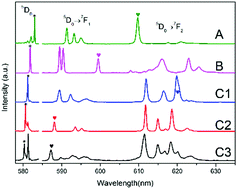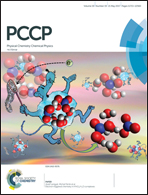Investigation on the site occupation of rare-earth ions in CaIn2O4 with the fluorescence probe of Eu3+
Abstract
Rare-earth doped CaIn2O4 phosphors have been widely investigated due to their excellent luminescent property, but the site occupation of rare-earth ions in CaIn2O4 is not very clear and needs to be clarified. Using Eu3+ as a fluorescence probe, such a clarification has been made in this work. 1% and 2% Eu3+ doped CaIn2O4 powder samples have been prepared by the sol–gel method. The X-ray diffraction results indicate that the lanthanide doping does not influence the structure of CaIn2O4. Site selective excitation at low temperature disclosed five different luminescent centers marked as A, B, C1, C2 and C3. The spectral analysis revealed that the A and B sites belong to Eu3+ embedded in In3+ sites; the other three are attributed to Eu3+ substitution on Ca2+ sites, which show slight distortion. Energy transfers from the B site to the A and C1 sites were observed in the 2% Eu3+ doped CaIn2O4 sample. The transitions of Eu3+ ions in the Ca2+ sites make the main contribution to the emission spectra excited at room temperature. These results may provide a guide for optimizing rare-earth doped CaIn2O4 phosphors for their application in the solid state lighting field.



 Please wait while we load your content...
Please wait while we load your content...